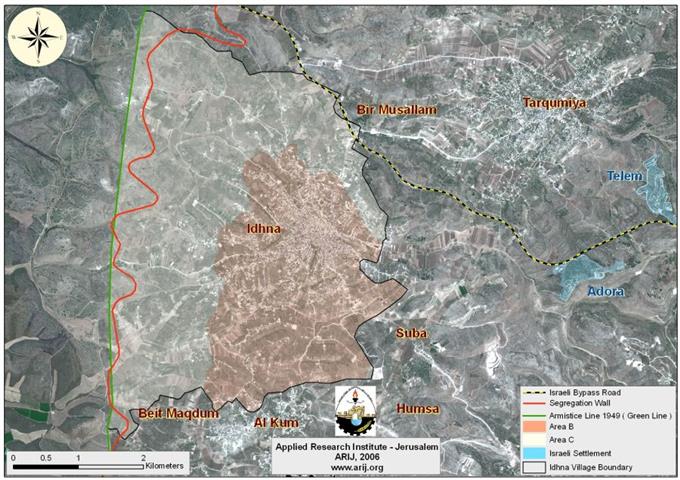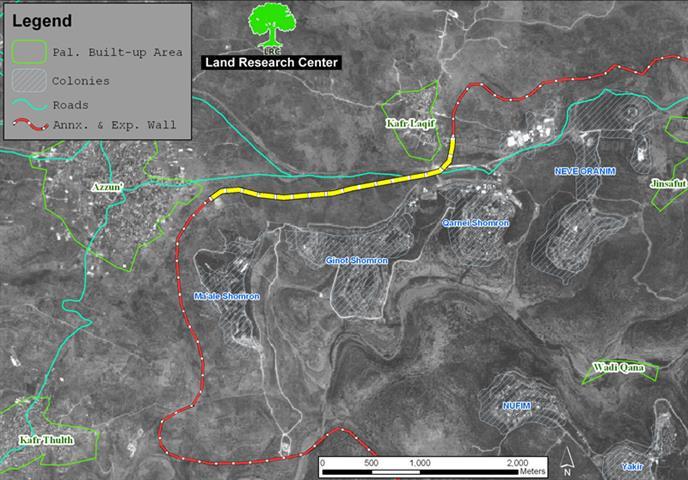Background
Idhna is a small village located some 12 km northwest of Hebron city, at the southern part of the West Bank. The 20001 dunums village rises 400-500 meters above sea level has a population of 18,199 (PCBS 2005). The land area that defines Idhna today constitute only52% of its originals lands area; as some 18000 dunums were annexed to Israel in 1952 after the demarcation of the 1949 Armistice Line. Today, a cluster of Palestinian villages from the south, the Israeli Segregation Wall from the west, the Israeli bypass road # 35 and two Israeli settlements (Adora, established in 1982 and Telem established in 1981) from the east and Bir Musallem Security observation tower and Tarqumiya checkpoint from the north surrounds Idhna.
According to Oslo's Accord land classification, Idhna's lands were sorted as listed in the following table:
|
Land classification of Idhna village boundary |
|
|
Area B |
7862 |
|
Area C |
12139 |
|
Total |
20001 |
As indicated in the table above, the Palestinian Security has no jurisdiction in Idhna whatsoever, only an administrative authority (Area 'B'), where as the remaining area 'C' falls under the Israeli Army's control. The following table shows Idhna's landcover/ landuse.
|
Idhna's landcover/ landuse |
|
|
Arable Land |
7654 |
|
Built-up Area |
3216 |
|
Other |
9131 |
|
Total |
20001 |
Source: ARIJ-GIS Database 2006
Idhna and the Israeli Segregation Wall
Idhna's suffering journey with the Israeli occupation continued over decade with relentless Israeli harassments, house demolitions, restriction of movement, threatening and destroying crops and cultivated lands, constant jeopardy to cut of means to livelihood and now the Israeli Segregation Wall. In September of 2004, Israel started the construction of the Segregation Wall in the southern part of the West Bank; part of which took place along 7 Km west of Idhna village. Today, August 2006, the Israeli Segregation Wall caused to isolate 1386 dunums from the village land area that will only become accessible to the Palestinian owners with special access permits issued by the Israeli civil administration. See Map of location
The effects of the Segregation Wall in Idhna village reflect on the various aspects of the residents’ lives in the village.
Mr. Jamal Al Tmezzi the Mayor of Idhna indicated that the village is suffering economically as the unemployment ratio now exceeds 50% due to the Israeli closures, military barriers and the apartheid Segregation Wall. Palestinian workers from Idhna are no longer able/ allowed to reach to their work in the construction sector in Israel thus causing more than 50% of Idhna's working power to lose their jobs and only source of income. Farmers were denied access to lands isolated west of the Segregation Wall (1386 dunums); also to lands within 150 meters east of the Segregation, which is equivalent to 1050 dunums.
The Wall and the International Legitimacy
The construction of the Segregation Wall is a flagrant violation of International law rules and conventions and United Nation resolutions which don’t permit the annexation of land by force and protects the rights of people under occupation as stated by Geneva Conventions, article 47: 'Protected persons who are in occupied territory shall not be deprived, in any case or in any manner whatsoever, of the benefits of the present Convention by any change introduced, as the result of the occupation of a territory, into the institutions or government of the said territory, nor by any agreement concluded between the authorities of the occupied territories and the Occupying Power, nor by any annexation by the latter of the whole or part of the occupied territory'.
Article 46 of the Hague Convention (Laws and Customs of War on Land (Hague II); July 29, 1899).Prohibits the confiscation of private property in occupied territory. Therefore, the confiscation of land by the Israeli government for construction of the Segregation Wall is a blatant violation to International laws and Conventions.
In July 2004, the International Court of Justice (ICJ) declared in its advisory opinion that the Segregation Wall which Israel is constructing in the West Bank is “illegal”. The Court based its decision on existing international law, including the Fourth Geneva Convention, the Hague Regulations, and various human rights treaties, and UN Security Council resolutions. The Wall violates the Right to Self-Determination, and the Law of Belligerent Occupation, and Human Rights Law.
Despite that, Israel continues its massive policy against the Palestinian residents of Idhna, in apathy to the international conventions, laws and international legitimacy.
Prepared by
The Applied Research Institute – Jerusalem
ARIJ













